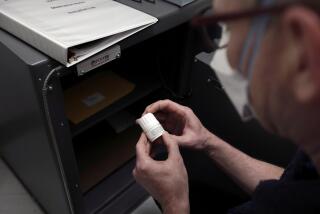Hope, Skepticism Surround Research Into a Cure for Cocaine Addiction : Drugs: Some scientists see promising results from the hunt for a medicine to kill the craving. Others say a biochemical approach isn’t the whole solution.
PHILADELPHIA — For more than four years, Sam Heath says, his life was a “string of broken promises” to quit smoking crack. No matter how many times he vowed to do it, every two weeks his paycheck arrived and “it was like Dr. Jekyll and Mr. Hyde,” Heath said. “A transformation would come over me, and I would go on these binges.”
Then drug researchers here offered the stocky, 36-year-old shipyard worker an unusual alternative: little red pills of amantadine, a drug that has been around for many years for treating certain viral infections and Parkinson’s disease. Oddly, some scientists believe, it also reduces the brain’s craving for cocaine.
The pills “calmed me down a bit,” said Heath, who has not touched crack since the two-week experiment a year ago but remains in treatment. “Somewhere in the recesses of my mind, I believed it was helping me.”
Nobody is yet calling amantadine a cure for crack. But in agreeing to take the pills, Heath became one of the first subjects in a burgeoning research effort that some argue may be among the most important fronts in the drug war: the search for a medicine that will kill the craving for cocaine and its smokable derivative, crack.
Other scientists are skeptical, pointing out that while there are many testimonials, the evidence in favor of using drugs to cure drug abuse remains unconfirmed. They also note that drug abuse is a broader problem than mere biochemistry in an addict’s body. And, to be fair, the meaning of Heath’s testimonial is unclear. No one will know until the end of the experiment whether he got the experimental drug or the placebo.
After years of frustration trying to treat cocaine and crack abusers, federal anti-drug officials are encouraging an all-out effort to discover new methods of breaking addicts of their habits. They are experimenting with unorthodox medical techniques, such as Chinese acupuncture, and novel “conditioning” therapies, including one study in which addicts are being “bribed” to quit with the use of exchangeable vouchers.
The centerpiece of these efforts, however, is an ambitious program aimed at developing anti-cocaine drugs--a project that is expected to cost more than $500 million over the next decade and which some officials are likening to the search for an AIDS vaccine.
Already, some officials say, there is cause for optimism. Over the last few years, scientists have developed new insights into the powerful, long-term grip cocaine can have on key pleasure centers in the brain. And a series of small clinical trials has shown that some antidepressants and other drugs may reduce the craving for cocaine, making addicts more receptive to counseling and other conventional forms of treatment.
“It’s very exciting and very promising,” said Frederick K. Goodwin, administrator of the Alcohol, Drug Abuse and Mental Health Administration. “This is not a ‘maybe someday we’ll have something.’ This is more of an engineering problem. . . . I would say we’re reasonably near a medication that will sufficiently blunt the craving in a significant portion of cocaine addicts. . . . I’d put it in the five- to 10-year range.”
Officials of ADAMHA’s National Institute on Drug Abuse last year created a new “medications development” program to fund experiments on animal and human subjects with about 30 different drugs. Encouraged by early results, Goodwin and other officials say they plan to triple the program’s budget from $35 million to $100 million in the next two years and then sustain that level for the rest of the decade.
“I think cocaine is going to be the first drug we can conquer,” said James Halikas, a University of Minnesota psychiatrist who is receiving NIDA funding under the program and is considered one of the leading researchers in the field. “We’re learning so much about it so rapidly--more than any other drug we’ve attacked.”
Halikas said he has been able to reduce drastically the cocaine use of a group of nearly 30 addicts by giving them carbamazepine, an anti-convulsant that has long been used to treat epileptics. Other scientists have reported similarly promising results with antidepressants such as desipramine and imipramine. In a continuing study, five of 10 patients given two weeks worth of amantadine stayed drug-free for a month while only one of 10 given a placebo did.
And some of the research is veering off in unorthodox areas. One drug NIDA plans to test is ibogaine--a plant extract used in West African tribal rituals. When taken by young initiates, ibogaine puts them into a “dreamlike” state in which they “visualize repressed memories,” says Howard S. Lotzof, president of a New York firm that has a patent on the drug and believes it can cure both cocaine and heroin addiction.
In an informal survey at a recent conference of addiction therapists, Halikas said he found 32 psychiatrists who reported treating a total of as many as 12,000 cocaine addicts with these drugs. “There are a lot of people out there using these,” Halikas said. “They appear to be doing something.”
But some scientists are sounding a more cautious note, pointing out that all of the studies have been on small groups of subjects (in most cases fewer than 50) and have not been duplicated by other researchers. “It’s very discouraging. You get these uncontrolled studies on” small groups of patients and “then the researchers call press conferences,” said a clinical pharmacologist here who asked not to be identified. “It’s politics. It’s not science.”
Some skeptics like to point out that heroin was developed by medical researchers as an allegedly non-addicting medicine to treat morphine abusers.
Perhaps more significantly, many scientists warn it is unrealistic to expect a wonder drug cure--that the nation’s cocaine problems are as deeply rooted in behavioral and social causes, especially in the inner city where the crack trade has flourished, as they are in brain chemistry.
“There’s no way a drug is going to cure addiction,” said Charles O’Brien, director of the University of Pennsylvania’s Center for Addiction Studies. “You’re not dealing with something that is all-or-nothing, like a broken leg. . . . You’re dealing with a behavioral problem that has multiple causes.”
Whatever the ultimate role for medications, there is little debate about the need for help. In the late 1960s, federal anti-drug officials were greatly aided by the development of methadone--a synthetic narcotic that has been highly successful in treating heroin addicts. Methadone, however, remains controversial because it is an opiate, is habit-forming and has spawned a class of methadone addicts.
In any case, no comparable “substitute” drug yet exists for cocaine.
The problem is given further urgency by new reports about the behavior of crack addicts that belies some of the recent progress claimed by William J. Bennett, director of national drug control policy. Only a few years ago, some researchers had postulated that the number of crack abusers would begin to decline through natural “burn out”--that is, that the body would simply be unable to sustain the frenetic lifestyle and repeated stimulation of chronic crack use, prompting addicts to turn to sedatives such as heroin.
But so far there is no evidence that this is happening. Marian Droba, a University of Pennsylvania psychiatrist who directs the drug treatment clinic at the Veterans Hospital here, said that crack abusers she sees report using the drug for increasingly longer periods of time than they did a few years ago.
This means that, even while the casual use of cocaine declines, there is left behind a vast population of hard-core cocaine and crack abusers (about 2.2 million, according to a recent Senate Judiciary Committee report) that will be largely untouched by expansion in treatment services, some officials warn. While increasing education and treatment can “pick away” at the number of cocaine and crack users, “the long-term answer is developing a medication,” argues Herbert Kleber, Bennett’s chief deputy for “demand reduction.”
In their effort to find medications, researchers here and elsewhere report they are already being helped by surprising new discoveries about the nature of cocaine, and crack in particular, that in many ways clash with widespread public perceptions of the drug.






